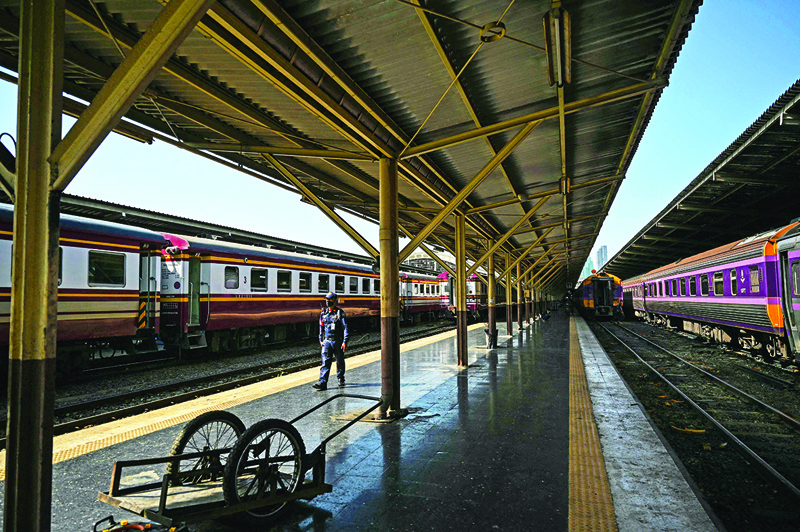 BANGKOK: This photo taken on June 22, 2021 shows a security guard patrolling the platforms at Bangkok Railway Station, more commonly known as Hua Lamphong, in Bangkok. - AFP photos
BANGKOK: This photo taken on June 22, 2021 shows a security guard patrolling the platforms at Bangkok Railway Station, more commonly known as Hua Lamphong, in Bangkok. - AFP photos
An uncertain fate awaits the hawkers, drivers and rough sleepers who have made a second home under the ornate arched ceiling of Bangkok's century-old central railway station. The elegant Italianate columns and stained glass windows of the station at Hua Lamphong will soon echo no more to the constant rattle of trains arriving and departing.
The vast majority of services will move to a new rail hub on the capital's northern outskirts later this year, with plans for eventual fast services to China through neighbouring Laos. The coronavirus pandemic has already bought a year's reprieve for the current station, near the city's Chinatown district -- its replacement is almost finished but currently being used as a vaccination centre.
But movement restrictions and a lack of foreign visitors have crippled the kingdom's tourism-dependent economy and the dozens of people eking out a living are already feeling the pinch. "We have to be very frugal -- I'm using my savings to cover living expenses," said Boonkerd Khampakdi, who has sold food to hungry travellers at the station for the past 20 years.
The 51-year-old told AFP she now makes only 1,000 baht ($30) per day, a tenth of what she made before the pandemic and barely enough to cover monthly rent for her stall. Nearby, tuk-tuk driver Wutthisak Inthawat waits patiently for what few potential fares pass through the station's entrance. He said it had been increasingly difficult to cover the hire fees for his vehicle, pay rent and feed his family. "I have two young daughters -- a three and nine-year-old," said Wutthisak, 34. "If I can't manage to pay off my debts I will have to return to my home province."
 This aerial photo taken on August 20, 2021 shows the Bangkok Railway Station.
This aerial photo taken on August 20, 2021 shows the Bangkok Railway Station.
'Grandiose and austere'
The long platforms and languid atmosphere of the Hua Lamphong station have long imbued an element of romance to rail travel in Thailand. It was a crowning achievement for Italian architect Mario Tamagno, who worked extensively in Thailand at the turn of the century and whose blueprints drew inspiration from the Frankfurt central station in Germany, built near the end of the 19th century.
"The structure itself is quite imposing, in that neo-Renaissance style and it's quite ornate and almost grandiose and austere in a way," said Dave Kendall, the former host of travel TV show Destination Thailand. Work on the terminal began in 1910 and the first train rolled into the station six years later. The fountain that now greets visitors at the station's main entrance sits at the site of what was once a 100-person bunker built after the Japanese invasion of Thailand during World War II, local train enthusiast Wisarut Bholsithi told AFP.
A bomb hit the vault during an Allied air raid and killed all those taking shelter inside, he added. At its pre-pandemic peak, the station handled 37 million passengers each year, according to the State Railway of Thailand. Authorities plan to turn the station into a train museum -- coupled with commercial space -- as a way to preserve the building's heritage. Less clear is what the future holds for the small community of homeless who sleep rough around the station, relying on donations from a dwindling number of passing travellers to survive. "Right now I don't have enough food to eat every day, I drink water to ward off hunger," said Nares Kaysao, who has been homeless for 20 years. "I don't know what will happen when there are no passengers." - AFP




